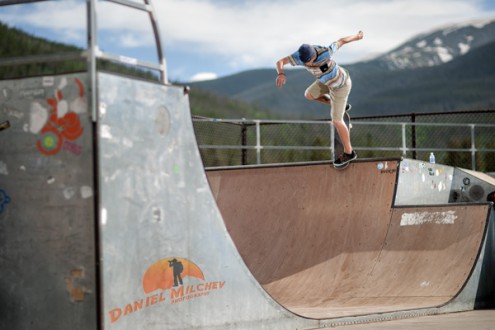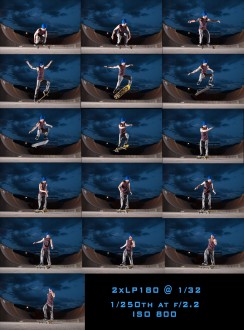LumoPro LP180 Review
After weeks of rough and dusty testing, we can now officially offer our opinions on the LumoPro LP180 flash. This isn't just a quick review, but a real in-depth look at the flashes and real world performance. (Spoiler Alert!!! We are blown away by how well this $199 flash performs!)
Build-Quality/Design: The new LumoPro LP180 looks significantly more professional and feels more solid than any other LP flash previously released, it even feels burlier than our Nikon and Canon flashes. From the first time you see and feel the flash you'll notice how solid this thing really is. Not only is it tough looking, but the hard plastic has an extremely durable feeling. It fits in perfectly in the extreme sports community since it's super strong, and has an action look with an "X" plastic cutout on the top. The Design of it almost makes it look like a battle tank, ready to shoot anything you throw at it.

P: Connor Walberg
Every detail has been considered with this flash, right down to the hot shoe. The hot shoe has a similar build style to the Canon shoes, but seems to seal better than anything we've seen. The locking mechanism slides smoothly and snaps into place for a very firm hold that you won't have to worry about (something Nikon users usually do have to worry about…) Not only that, but the weather sealing on the shoe slides down to cover it as well.
This flash also has an innovative new idea that is so simple you wonder how come no one had thought of it before. On the side of the head is a threaded 3/8" port that lets you twist the flash directly onto a lightstand without a bracket. This is a great feature for traveling lighter, and provides for a very solid mount, especially when you realize you forgot your mounting bracket….
The only detail on the outside we could see changing, would be to put separate access panels for each of the sync ports. It seems a little vulnerable to have the sync ports all exposed to the elements when you are only using one. However, it makes sense that it was made this way to help keep costs down and save us some money on purchase price.

The Menu:
The flashes built-in menu is pretty straight forward, simplified and intuitive. Power output is simply controlled by the + and – button, and after choosing a certain power setting, the value(1/1 – 1/128th in 1/3rd increments) blinks 3 times before it's set. The left and right arrows are responsible for the zoom setting of the head( 24mm – 105mm). Plus you get the optional wide angle/14mm pull out adapter, along with a white bounce card.
By holding the SET button for 3 seconds you get into a sub menu where you can set the following options:
Sleep
BackLight – The screen light is optional.
Sound – You can get sound conformation when the flash is fully loaded and ready to fire. (Great for when you are shooting a lot and need confirmation!)
There's also a Slave button, which needs to be held for 3 sec. to give you access to the slave mode option.
Then you have the Test button, which fires a test flash at the current power setting.
The last button is the Power Button, it's white, well marked and right in the middle. It needs to be held for about 1.5-2 sec. to start or power down the flash.
All the buttons have a great(non cheap) feel to them, and are very responsive.
LumoPro LP180 Color Gels(sets & mounting): One very cool feature that these ship with is a full set of gels for both color balancing and special effects. The flash has an extra "lip" on the top and bottom of the lens that lets you slide these oversized gels in so that they bow outwards and won't melt. It's a very simple and clever design that works great.
In The Field: The flash performed flawlessly in the field and never skipped a beat. It also has a very fast refresh time and doesn't seem to drain batteries, both features that are highly coveted by action sports photographers. The refresh time is quoted at 4 seconds with standard batteries, but with our Sanyo Eneloops we have been getting significantly faster recycles. After about 400-500 1/4 and up to full power shots, our battery gage (that's right, it has a gage!!) still showed 3 out of 4 bars. It might be the Sanyo Eneloops that we have in there, but it's significantly more than our other flashes can do.

p: Connor Walberg
Triggering with PocketWizards worked perfectly, once it was setup right… For some reason, you need to turn on the flash first, then the pocketwizards to get it to trigger correctly. This is the opposite of how PW say's it needs to be done. Sometimes it would take several clicks of the test button to get it to pop after first turning everything on, but I'm assuming that's due to the PW Flex that I was using more than the flash itself, expecially with all the problems I've had with that system so far.. (The Flex and Mini system may give us HyperSync, but it curses us with horrible reliability and constant connectivity issues….) When tested with other variations of pocketwizards everything performed flawlessly. We would recommend using a different system than the Flex as well since it has no advantages with a manual flash other than hypersync mode over other radios.
Once it was all setup it exceeded our expectations with super fast recycle times and popped every time. It's impressive to be able to shoot a full blown sequence at lower power with a small flash and have it keep up!
Another cool feature is the ability to trigger it as an optical slave. This works by popping the flash as soon as it sees another one pop (don't worry, it happens faster than it sounds!). By doing this, you won't need an extra radio trigger, and can carry less gear. Of course we wouldn't recommend this for event work, since it will go off like crazy, but for personal work and in a pinch (we've all forgotten some piece of vital gear at one point or another!) this is a great solution. The optical slave mode also has delays built in so that you can set it to ignore the pre-flashes if you are using other flashes in TTL mode. This way it won't trigger too early. By doing this you can add these to the Nikon/Canon or whatever model flashes you already have and they will fit right in.

p: Connor Walberg
Freezing Action & Hyper Sync
Using the flash with just basic triggers will allow you to use it at up to your camera's default sync speed, since it is a "basic" flash, it doesn't offer TTL, Rear Curtain Sync or HSS. But on the other hand you don't really need anything more. As an example we'd say that 99% of the time when using some of the newest/most advanced flashes on the market, we simply use them in full manual mode, which gives you the most control, reliability and predictability. So if you are used to shooting with off camera flashes in manual mode, you got nothing to worry about. And even if you aren't, it's fairly simple to learn how to shoot manually. The flash has great freezing power, and as with most other hot shoe flashes, you get the slowest flash duration when the flash is set to full power. The number is still way over your default sync speed, and is plenty to freeze action.
For those familiar with Hyper Sync, we did some testing and experimentation with the LP180, and the results are not much different than most of the other flashes that we have worked with. At 1/1000th of a sec with the LP180 set to full power, we were able to get a perfectly exposed frame. By increasing the shutter speed to 1/1600 or 1/2000th of a second, we started seeing a bit of the curtain on the lower portion of the frame. But it's still 100% usable for action. By decreasing the power of the flash, the flash duration gets very fast and noticeable fall off appears at the top part of the screen.

We also played with the recycle times, and FPS(Flashes Per Second). With two LP180s on both sides of a skateboarder set to 1/32nd power and a Canon 1D set to it's maximum frame rate of 10, ISO 800 and 1/250th shutter speed. Although it wasn't getting 10fps, the results were amazing. The new LPs just kept popping and poppin.
CONCLUSION: It's obvious from the first time we picked these flashes up that they were built with serious photographer's needs in mind. It has features that flashes more than twice the price still don't. Don't get one of these if TTL and high-speed sync are your forte however, but if that's the case, maybe it's time to try manual and take back control! For the price these will also make a great addition to your current flashes, and can be triggered with the optical slave easily. We recommend these flashes highly for action sports photographers!

Technical Details (Hypersync for those who use this!):
The LumoPro LP180 is now available for ordering through the LumoPro website. Orders will ship out Tuesday, July 16th.








No comment posted yet.